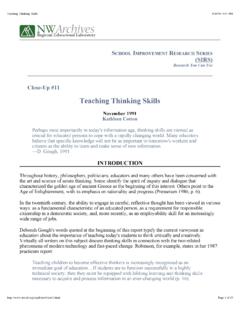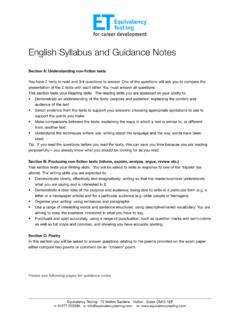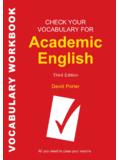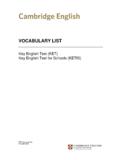Transcription of Teaching English Vocabulary - qsm.ac.il
1 Teaching English Vocabulary Abdul Kareem Igbaria Abstract This article claims that Teaching Vocabulary is a very important field, and it is more than just presenting and introducing new Vocabulary to the learners. Knowing words is not filling papers with new words and memorizing them. The article suggests that what students need to understand is the word meaning in context and how words are used. This can be achieved, according to the article, through correct Vocabulary instruction which should involve Vocabulary selection, word knowledge and techniques. The article presents and describes these concepts and provides examples and techniques that illustrate how teachers can handle Vocabulary Teaching in an effective way. Teaching English Vocabulary is an important area worthy of effort and investigation. Recently methodologists and linguists emphasize and recommend Teaching Vocabulary because of its importance in language Teaching .
2 Vocabulary is needed for expressing meaning and in using the receptive (listening and reading) and the productive (speaking and writing) skills. If language structures make up the skeleton of language, then it is Vocabulary that provides the vital organs and the flesh (Harmer ). Vocabulary is not a syllabus, , a list of words that teachers prepare for their learners to memorize and learn by heart. Memorizing may be good and useful as a temporary technique for tests, but not for learning a foreign language. Language students need to learn Vocabulary of the target language in another way. If we are really to teach students what words mean and how they are used, we need to show them being used together in context. Words do not just exist on their own; they live together and they depend upon each other. Therefore, Teaching Vocabulary correctly is a very important element in language learning.
3 Correct Vocabulary instruction involves Vocabulary selection, word knowledge and techniques. In the past, teachers used to select and present Vocabulary from concrete to abstract. Words like door , window , desk , etc., which are concrete, used to be taught at beginning levels. However, words like honesty , beauty etc., which are abstract words, used to be taught at advanced levels because they are not physically represented in the learning/ Teaching environment and are very difficult to explain. Nowadays methodologists and linguists suggest that teachers can decide and select the words to be taught on the basis of how frequently they are used by speakers of the language. That is, the most commonly used words should be taught first (Harmer ). We can get information about which words will be most useful for learners of English by looking at frequency counts of Vocabulary .
4 Usually a Vocabulary count is done by making a list of the words in a particular text or group of texts and counting how often and where they occur. Some of the more recent counts have used computers to list the words and count their frequency (Nation ). Besides that, teachers can decide which words are useful and should be taught to their learners on the basis of semantics. This means, that the word is more useful if it covers more things than if it only has one very specific meaning. For example, the word book , which is taught at beginning levels, has wider usage than the words notebook , textbook , etc. Furthermore, Nation says that frequency and coverage are not enough to be used when teachers select and prepare a word list for learners of English . So he suggests other criteria, such as language needs, availability and familiarity, regularity and ease of learning or learning burden.
5 Teachers can help their learners enrich and increase their Vocabulary . They can also help the learners to build a new store of words to select from when they want to express themselves. If any learner can handle grammar correctly, that does not mean that he can express himself fluently unless he has a store of words to select from. Therefore, teachers are a very important factor in selecting and Teaching English Vocabulary , and they have to design Vocabulary syllabi according to their learners needs. As a result, (Teachers ) Vocabulary work can be directed toward useful words and can give learners practice in useful skills (Nation ). The selection of words which are to be taught to the students is a very important procedure in the language learning process. However, the word selection process doesn t mean that the students will be fluent in expressing themselves in English upon learning that list, , what students need to know regarding Vocabulary is the word meaning, the word use, the word formation and the word grammar.
6 When conveying the meaning to the students, teachers should teach their students that a word may have more than one meaning when used in different contexts. For example, the word book has at least twelve different meanings when used in context. It has eight meanings as a noun, two meanings as a verb and three different meanings when used with prepositions as phrasal verbs. One may say I booked my ticket three days ago ; another I booked him for speeding and so on (Harmer ). Teachers should make the Teaching learning Vocabulary process clear and easy for their students when conveying any meaning; otherwise the student may feel bored and become fed up with learning Vocabulary . The meaning of words can be communicated in many different ways. Nation suggests that teachers can convey meaning to their students by demonstration or pictures (using an object, using a cut out figure, using gesture, performing and action, photographs, blackboard drawings or diagrams and pictures from books) and by verbal explanation (analytical definition, putting the new word in a defining context, and translating into another language) (Nation ).
7 Besides that, teachers should involve their students in discovering the words meanings by themselves and let them make efforts to understand words meanings. When the students are involved in discovering meaning, they will never forget those meanings and they will be able to express themselves fluently. When a single word has various meanings, the teacher should decide which meanings are to be taught first, , the teacher must decide which meanings occur most frequently and which meanings the learners need most. As a result, the students will be motivated, and gradually they will build their own store of words which will be a basis for communication at any time. Furthermore, students should be familiar with the words meanings when words are used in metaphors and idioms, and they should know when to choose the right word for the right place. We know that the word hiss , for example, describes the noise that snakes make.
8 But we stretch its meaning to describe the way people talk to each other ( Don t move or you re dead, she hissed.). That is metaphorical use (Harmer ). Students also need to know the different forms words have and when to use them. Thus the verb run has the participle running and run . The present participle running can be used as an adjective and run can also be a noun. Therefore, word formation is a very important part in Teaching Vocabulary . Getting familiar with the different forms of words, the students can easily know how to use the words in writing and speaking. Moreover, word grammar is one of the most important parts that students should be taught carefully. Teachers should give the students the opportunity to be exposed to grammatical patterns and to practice them frequently, such as nouns (countable and uncountable), verb complementation, phrasal verbs, adjectives and adverbs.
9 Therefore, different parts of speech should usually be taught separately because they occur in differing sentence pattern, but they need not be widely separated in a course if their meanings are very similar (Nation ). Teaching Vocabulary is not just conveying the meaning to the students and asking them to learn those words by heart. If teachers believe that the words are worth explaining and learning, then it is important that they should do this efficiently. Teachers should use different techniques and activities in Teaching English Vocabulary to motivate the learners, enrich their Vocabulary and enable them to speak English properly. There are many techniques and activities that teachers can employ and use in Teaching Vocabulary , such as presentation, discovery techniques and practice. We will look at the C s approach (conveying meaning, checking understanding, and consolidation), which Celce-Murcia recommends every teacher to follow when using the above mentioned techniques.
10 In stage (conveying meaning), the items are presented to the students. In stage (checking for comprehension) exercises test how far the students have grasped the meaning of the items. In stage (consolidation), students deepen their understanding of the items through use and creative problem-solving activities (Celce-Murcia ). The conveying meaning stage, to present new Vocabulary to the learners, can be done in many ways, so that the learners can understand and grasp the words meanings. At the beginning levels, teachers can convey meanings by bringing realia into the classroom, , teachers can bring the objects themselves to the classroom and show them to the learners, such as pens , rulers , balls . However, when that is impossible (to bring the object to the classroom, such as cars , animals ), teachers can show their students pictures of those items. Besides that, teachers can use mime, action and gesture to convey meaning.








